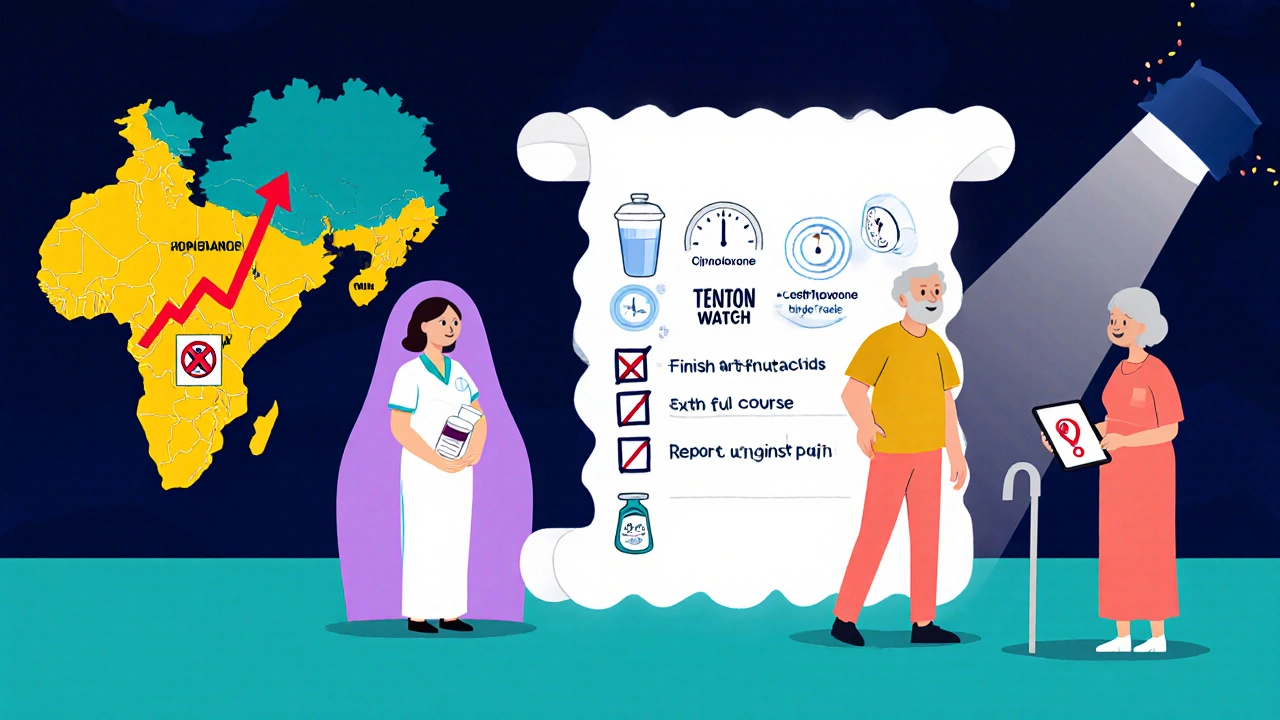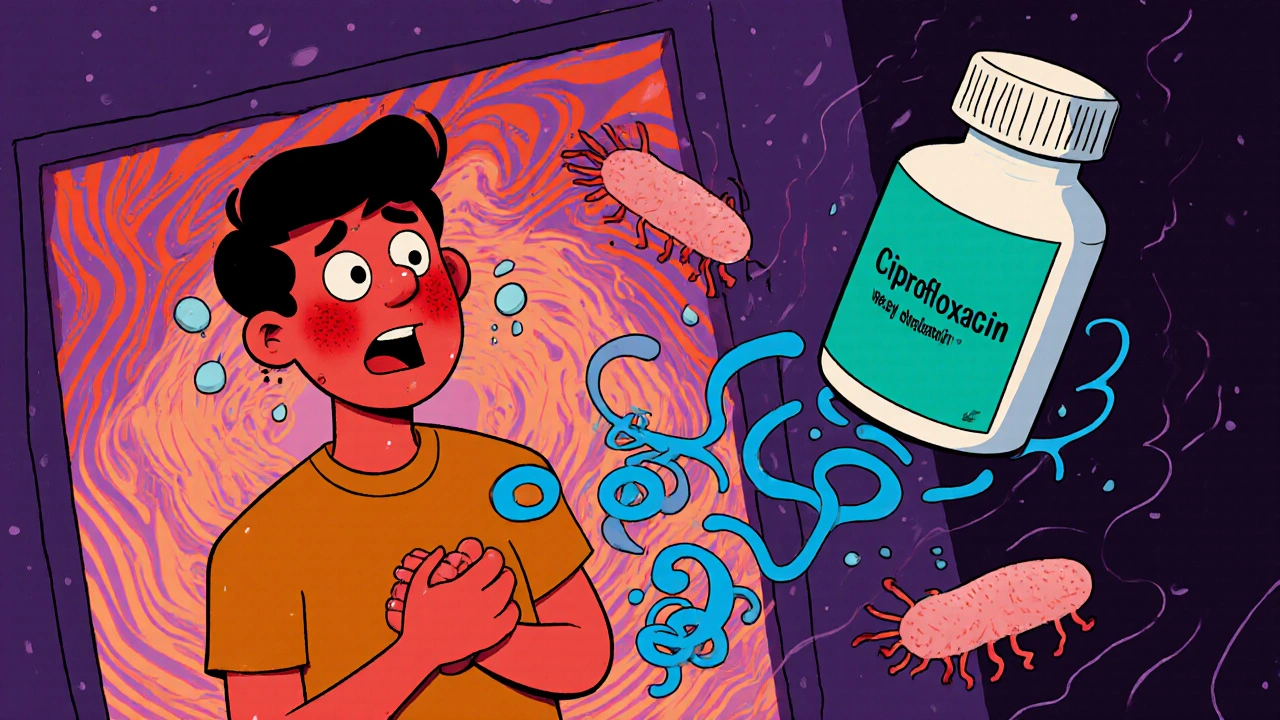Typhoid Fever Antibiotic Dosage Calculator
Select patient type and enter required information. The calculator will determine appropriate Ciprofloxacin dosage based on WHO guidelines.
Calculated Dosage
Treatment duration:
When a fever spikes, chills hit, and abdominal pain lingers, many wonder whether a simple pill could end the misery. For Typhoid Fever, Ciprofloxacin has become a go‑to option in many parts of the world. This guide breaks down what the drug does, who should take it, how to use it safely, and what to watch out for.
What is Typhoid Fever?
Typhoid Fever is a systemic infection caused by the bacterium Salmonella Typhi. The pathogen spreads through contaminated food or water, especially in regions with poor sanitation. Classic symptoms include sustained high fever (often above 39 °C), headache, rose‑colored spots on the trunk, and a distinctive “stepwise” worsening over weeks if untreated.
How Ciprofloxacin Works
Ciprofloxacin belongs to the Fluoroquinolones class. It blocks bacterial DNA gyrase and topoisomerase IV, enzymes essential for DNA replication. By crippling the bacteria’s ability to multiply, the drug clears the infection from the bloodstream within days.
When Is Ciprofloxacin Recommended?
- Confirmed diagnosis by blood culture or rapid antigen test.
- Susceptibility testing shows the strain is sensitive to fluoroquinolones.
- Patient is an adult without contraindications (e.g., severe tendon disorders, pregnancy).
- Local resistance rates are below 10 % according to recent WHO surveillance data.
If any of these conditions fail, clinicians may turn to alternatives like azithromycin or ceftriaxone.
Standard Dosage Regimens
Dosage depends on age, weight, and renal function. Below are the most widely accepted schedules:
- Adults (≥18 years): 500 mg orally every 12 hours for 7-14 days.
- Pediatric patients (6 months-18 years): 20 mg/kg body weight orally every 12 hours, not exceeding 500 mg per dose, for a minimum of 10 days.
- Severe or complicated cases: 400 mg IV every 12 hours, followed by oral step‑down therapy once fever subsides.
All doses should be taken with a full glass of water, preferably on an empty stomach to improve absorption. Food can reduce bioavailability by up to 20 %.

Monitoring and Safety
While Ciprofloxacin is generally well‑tolerated, clinicians monitor for:
- Tendon pain or swelling - a red flag for potential rupture.
- Neurological symptoms such as dizziness, confusion, or seizures.
- Gastrointestinal upset: nausea, diarrhea, or abdominal cramping.
- QT‑interval prolongation on ECG, especially in patients with cardiac disease.
Blood tests (CBC, liver enzymes) are advisable after a week of therapy to detect rare hematologic or hepatic reactions.
Antibiotic Resistance: A Growing Concern
Resistance to fluoroquinolones has surged in South Asia, with the FDA reporting a 15 % increase in resistant isolates between 2020 and 2024. Mechanisms include mutations in the gyrA gene and efflux pump overexpression. When resistance is suspected, switch to third‑generation cephalosporins (e.g., ceftriaxone) or macrolides (azithromycin).
How Ciprofloxacin Stacks Up Against Other Typhoid Antibiotics
| Drug | Class | Typical Adult Dose | Duration | Resistance Trend (2025) | Key Side Effects |
|---|---|---|---|---|---|
| Ciprofloxacin | Fluoroquinolone | 500 mg PO q12h | 7-14 days | ↑ (12 %) | Tendonitis, QT prolongation |
| Azithromycin | Macrolide | 1 g PO single dose or 500 mg PO daily | 5-7 days | Stable (3 %) | GI upset, hepatotoxicity |
| Ceftriaxone | Third‑generation cephalosporin | 2 g IV q24h | 10-14 days | Low (1 %) | Allergic reactions, biliary sludging |
In settings where fluoroquinolone resistance is <10 %, Ciprofloxacin remains the most cost‑effective option. In high‑resistance zones, azithromycin or ceftriaxone are preferred.

Special Populations
Pregnancy: Fluoroquinolones cross the placenta and are linked to cartilage defects in animal studies. The WHO advises against their use in the first trimester; switch to ceftriaxone instead.
Renal impairment: Reduce the dose by 50 % if creatinine clearance <30 mL/min. Monitoring serum drug levels can prevent accumulation.
Children under six months: Data are limited; clinicians often opt for parenteral ceftriaxone.
Practical Tips for Patients
- Finish the full course, even if you feel better after a few days.
- Avoid taking antacids or calcium supplements within two hours of the dose.
- Stay hydrated to reduce the risk of kidney stones.
- Report any sudden joint pain, vision changes, or heart palpitations promptly.
Frequently Asked Questions
Can I take Ciprofloxacin with food?
Food can lower the drug’s absorption, so it’s best taken on an empty stomach. If stomach upset occurs, a light snack is acceptable, but wait at least two hours after eating.
How quickly will fever drop after starting treatment?
Most patients see a temperature drop within 48‑72 hours, provided the infecting strain is susceptible.
What if my local lab reports Ciprofloxacin resistance?
Switch to azithromycin (500 mg daily for 7 days) or a ceftriaxone injection, based on clinician guidance.
Is Ciprofloxacin safe for elderly patients?
Yes, but watch for tendon problems and kidney function. Dose adjustments may be needed if creatinine clearance falls below 30 mL/min.
Can I use Ciprofloxacin for other infections at the same time?
Only under medical supervision. Combining fluoroquinolones with certain anti‑seizure meds or steroids can increase toxicity.
Understanding when and how to use Ciprofloxacin empowers patients and clinicians to combat Typhoid Fever effectively while minimizing risks.

Rajesh Singh
October 18, 2025 AT 19:30It's downright irresponsible to pop ciprofloxacin without confirming susceptibility; we must champion stewardship and keep those precious antibiotics from turning into relics of a bygone era.
Every time we cavalierly prescribe, we edge closer to a world where a simple fever becomes a death sentence.
Drew Waggoner
October 21, 2025 AT 03:03The shadows of resistance loom over every dose, and without a hint of optimism, one can only stare at the bleak horizon of endless microbial battles.
Mike Hamilton
October 23, 2025 AT 10:36People need to understand that ciprofloxacin is only part of a bigger picture; it works best when used wisely and can be combined with good hygiene.
Also, the lab tests sometimes miss the mark, so doctors should keep an eye on the local data.
Alex Lineses
October 25, 2025 AT 18:10From a pharmacokinetic standpoint, ensuring optimal plasma concentration requires adherence to the prescribed schedule; any deviation can compromise the AUC/MIC ratio and foster resistance mechanisms.
Joe Moore
October 28, 2025 AT 01:43Did you ever notice how big pharma never tells you about the hidden agenda? They push fluoroquinolones while the real cure is being suppressed by the shadowy elite controlling the labs.
Emma Williams
October 30, 2025 AT 09:16Great summary.
Stephanie Zaragoza
November 1, 2025 AT 16:50While the article presents a thorough overview, one must note that the adverse effect profile of ciprofloxacin, particularly tendonopathy, warrants vigilant monitoring; failure to do so could result in significant morbidity.
Janet Morales
November 4, 2025 AT 00:23Honestly, the drama around antibiotic resistance feels like an overblown soap opera, but the stakes are real; we can't just sit back and hope the microbes sort themselves out on their own.
Tracy O'Keeffe
November 6, 2025 AT 07:56Eh, the whole thing is just a mainstream narrative to keep us dependent on pricey meds; cheap natural remedies are being sidelined, and nobody talks about that in the official docs.
Liberty Moneybomb
November 8, 2025 AT 15:30They say ciprofloxacin is safe, but the hidden labs are testing it on unsuspecting populations; stay awake, stay skeptical, and question every dosage chart they hand you.
Brian Van Horne
November 10, 2025 AT 23:03In accordance with established protocols, adherence to the 500 mg bid regimen remains the standard of care for uncomplicated typhoid.
Norman Adams
November 13, 2025 AT 06:36Oh sure, because the world really needed another “miracle drug” article – as if anyone hadn’t seen a dozen of those before.
Margaret pope
November 15, 2025 AT 14:10Remember to keep patients hydrated and monitor labs; these steps help catch issues early and keep treatment on track
Karla Johnson
November 17, 2025 AT 21:43When we delve deeper into the pharmacodynamics of ciprofloxacin in the context of typhoid fever, several nuanced considerations emerge that warrant meticulous discussion.
First, the drug’s ability to achieve bactericidal concentrations hinges on maintaining a peak plasma level that exceeds the minimum inhibitory concentration (MIC) of the target Salmonella Typhi strain by a substantial margin.
Second, the timing of dose administration relative to meals can influence bioavailability, as high-fat meals have been documented to reduce absorption by as much as twenty percent.
Third, genetic polymorphisms in the host’s cytochrome P450 enzymes may affect drug metabolism, leading to inter‑patient variability that clinicians must anticipate.
Fourth, the emergence of gyrA mutations underscores the necessity for routine susceptibility testing, especially in regions with documented resistance trends.
Fifth, while therapeutic drug monitoring is not routinely performed for ciprofloxacin, it can be a valuable tool in complex cases where renal impairment alters clearance.
Sixth, the risk of tendonitis, though rare, escalates with concurrent corticosteroid therapy, a factor often overlooked during prescribing.
Seventh, clinicians should be aware of the drug’s potential to prolong the QT interval, particularly in patients with pre‑existing cardiac conditions or electrolyte imbalances.
Eighth, the interplay between ciprofloxacin and other medications, such as theophylline or warfarin, may necessitate dosage adjustments.
Ninth, adherence to a full 7‑14 day course is critical to prevent relapse and suppress resistance development.
Tenth, patients should be counseled on the importance of avoiding over‑the‑counter NSAIDs, which can exacerbate gastrointestinal side effects.
Eleventh, environmental considerations, such as proper disposal of unused antibiotics, help mitigate community‑wide resistance pressures.
Twelfth, emerging data suggests that combination therapy with azithromycin may offer synergistic benefits in multi‑drug‑resistant cases, though more research is required.
Thirteenth, the cost‑effectiveness of ciprofloxacin compared to newer agents remains advantageous in low‑resource settings, provided resistance rates stay low.
Fourteenth, public health initiatives focusing on sanitation and vaccination continue to be the cornerstone of typhoid prevention, with antibiotics serving as a secondary line of defense.
Fifteenth, ongoing surveillance by bodies like the WHO is essential to track resistance patterns and inform clinical guidelines moving forward.
Linda A
November 20, 2025 AT 05:16The philosophical underpinnings of modern medicine remind us that every prescription is a pact between healer and patient; we must honor that contract with diligence and humility.